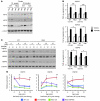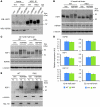Altered chromatin architecture underlies progressive impairment of the heat shock response in mouse models of Huntington disease
- PMID: 21785217
- PMCID: PMC3148745
- DOI: 10.1172/JCI57413
Altered chromatin architecture underlies progressive impairment of the heat shock response in mouse models of Huntington disease
Abstract
Huntington disease (HD) is a devastating neurodegenerative disorder for which there are no disease-modifying treatments. Previous studies have proposed that activation of the heat shock response (HSR) via the transcription factor heat shock factor 1 (HSF1) may be of therapeutic benefit. However, the effect of disease progression on the HSR and the therapeutic potential of this pathway are currently unknown. Here, we used a brain-penetrating HSP90 inhibitor and physiological, molecular, and behavioral readouts to demonstrate that pharmacological activation of HSF1 improves huntingtin aggregate load, motor performance, and other HD-related phenotypes in the R6/2 mouse model of HD. However, the beneficial effects of this treatment were transient and diminished with disease progression. Molecular analyses to understand the transient nature of these effects revealed altered chromatin architecture, reduced HSF1 binding, and impaired HSR accompanied disease progression in both the R6/2 transgenic and HdhQ150 knockin mouse models of HD. Taken together, our findings reveal that the HSR, a major inducible regulator of protein homeostasis and longevity, is disrupted in HD. Consequently, pharmacological induction of HSF1 as a therapeutic approach to HD is more complex than was previously anticipated.
Figures







Comment in
-
Shock and awe: unleashing the heat shock response to treat Huntington disease.J Clin Invest. 2011 Aug;121(8):2972-5. doi: 10.1172/JCI59190. Epub 2011 Jul 25. J Clin Invest. 2011. PMID: 21785212 Free PMC article.
Similar articles
-
Shock and awe: unleashing the heat shock response to treat Huntington disease.J Clin Invest. 2011 Aug;121(8):2972-5. doi: 10.1172/JCI59190. Epub 2011 Jul 25. J Clin Invest. 2011. PMID: 21785212 Free PMC article.
-
Dexamethasone induces heat shock response and slows down disease progression in mouse and fly models of Huntington's disease.Hum Mol Genet. 2014 May 15;23(10):2737-51. doi: 10.1093/hmg/ddt667. Epub 2013 Dec 30. Hum Mol Genet. 2014. PMID: 24381308
-
The heat shock response, determined by QuantiGene multiplex, is impaired in HD mouse models and not caused by HSF1 reduction.Sci Rep. 2021 Apr 27;11(1):9117. doi: 10.1038/s41598-021-88715-5. Sci Rep. 2021. PMID: 33907289 Free PMC article.
-
HSF1 and Its Role in Huntington's Disease Pathology.Adv Exp Med Biol. 2023;1410:35-95. doi: 10.1007/5584_2022_742. Adv Exp Med Biol. 2023. PMID: 36396925 Free PMC article. Review.
-
Hsf1 on a leash - controlling the heat shock response by chaperone titration.Exp Cell Res. 2020 Nov 1;396(1):112246. doi: 10.1016/j.yexcr.2020.112246. Epub 2020 Aug 27. Exp Cell Res. 2020. PMID: 32861670 Review.
Cited by
-
Opportunities and challenges for molecular chaperone modulation to treat protein-conformational brain diseases.Neurotherapeutics. 2013 Jul;10(3):416-28. doi: 10.1007/s13311-013-0186-5. Neurotherapeutics. 2013. PMID: 23536253 Free PMC article. Review.
-
Repression of the Heat Shock Response Is a Programmed Event at the Onset of Reproduction.Mol Cell. 2015 Aug 20;59(4):639-50. doi: 10.1016/j.molcel.2015.06.027. Epub 2015 Jul 23. Mol Cell. 2015. PMID: 26212459 Free PMC article.
-
Molecular Pathophysiology of Fragile X-Associated Tremor/Ataxia Syndrome and Perspectives for Drug Development.Cerebellum. 2016 Oct;15(5):599-610. doi: 10.1007/s12311-016-0800-2. Cerebellum. 2016. PMID: 27277287 Review.
-
Targeting Hsp70 facilitated protein quality control for treatment of polyglutamine diseases.Cell Mol Life Sci. 2020 Mar;77(6):977-996. doi: 10.1007/s00018-019-03302-2. Epub 2019 Sep 24. Cell Mol Life Sci. 2020. PMID: 31552448 Free PMC article. Review.
-
Cellular responses to proteostasis perturbations reveal non-optimal feedback in chaperone networks.Cell Mol Life Sci. 2019 Apr;76(8):1605-1621. doi: 10.1007/s00018-019-03013-8. Epub 2019 Jan 25. Cell Mol Life Sci. 2019. PMID: 30683983 Free PMC article.
References
-
- Bates G, Harper P, Jones L, eds.Huntington’s Disease . 3rd ed. New York, New York, USA: Oxford University Press; 2002.
Publication types
MeSH terms
Substances
Grants and funding
LinkOut - more resources
Full Text Sources
Other Literature Sources
Medical
Molecular Biology Databases

